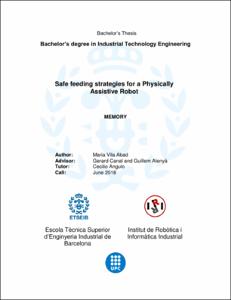Mostra el registre d'ítem simple
Safe feeding strategies for a physically assistive robot
| dc.contributor | Canal Camprodon, Gerard |
| dc.contributor | Angulo Bahón, Cecilio |
| dc.contributor.author | Vila Abad, Maria |
| dc.contributor.other | Institut de Robòtica i Informàtica Industrial |
| dc.date.accessioned | 2019-08-12T13:46:57Z |
| dc.date.available | 2019-08-12T13:46:57Z |
| dc.date.issued | 2018-06-21 |
| dc.identifier.uri | http://hdl.handle.net/2117/167484 |
| dc.description.abstract | With aging societies and the increase of handicapped people the demand for robots that can help nursing humans on-site is increasing. Concretely, according to World Health Organization (WHO) by 2030 more than 2 billion people will need one or more assistive products. With this perspective it becomes vital to develop assistive technology products as they maintain or improve disabled people’s functioning and independence. One of the most important activities that a person needs to be able to perform in order to feel independent is self-feeding. The main objective of this thesis is to develop software that controls a robot in order to feed a disabled person autonomously. Special attention has been given to the safety and naturalness of the task performance. The resulting system has been tested in the Barrett WAM® robot. In order to fulfill this goal an RGB-D camera has been used to detect the head orientation and the state of the mouth. The first detection has been realized with the OpenFace library whereas the second one has been realized with the OpenPose library. Finally, the depth obtained by the camera has been used to identify and cope with wrong detections. Safety is an essential part of this thesis as it exists direct contact between the user and the robot. Therefore, the feeding task must be completely safe for the user. In order to achieve this safety two di˙erent types of security have been considered: passive safety and active safety. The passive safety is achieved with the compliance of the robot whereas active safety is achieved limiting the maximum force that is obtained with a force sensor. Some experiments have been carried out to determine which is the best setup for the robot to ensure a safe task performance. The designed system is capable of automatically detecting head orientation and mouth state and decide which action to take at any moment given this information. It is also capable of stopping the robot movement when certain forces are reached, return to the previous position and wait in this position until it is safe to perform that action again. A set of experiments with healthy users has been carried out to validate the proposed system and the results are presented here. |
| dc.language.iso | eng |
| dc.publisher | Universitat Politècnica de Catalunya |
| dc.rights.uri | http://creativecommons.org/licenses/by-nc-nd/3.0/es/ |
| dc.subject | Àrees temàtiques de la UPC::Enginyeria biomèdica::Robòtica mèdica |
| dc.subject.lcsh | Human-robot interaction |
| dc.subject.lcsh | Robotics in medicine |
| dc.title | Safe feeding strategies for a physically assistive robot |
| dc.type | Bachelor thesis |
| dc.subject.lemac | Interacció persona-robot |
| dc.subject.lemac | Robòtica en medicina |
| dc.identifier.slug | ETSEIB-240.135219 |
| dc.rights.access | Open Access |
| dc.date.updated | 2018-07-13T05:25:11Z |
| dc.audience.educationlevel | Grau |
| dc.audience.mediator | Escola Tècnica Superior d'Enginyeria Industrial de Barcelona |
| dc.audience.degree | GRAU EN ENGINYERIA EN TECNOLOGIES INDUSTRIALS (Pla 2010) |


